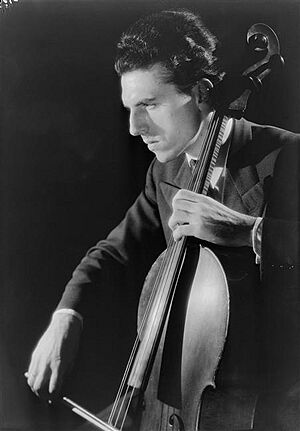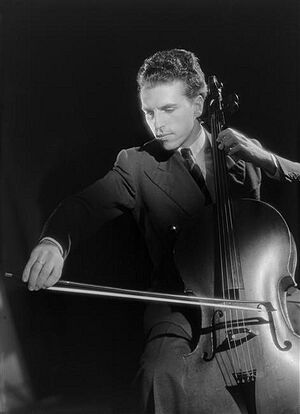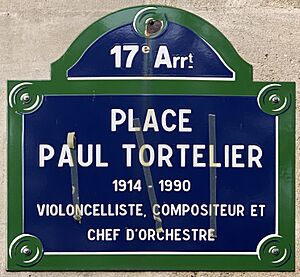Paul Tortelier facts for kids
Paul Tortelier (born March 21, 1914 – died December 18, 1990) was a famous French cellist and composer. He was an amazing student at the Conservatoire de Paris. Before World War II, he played in orchestras in France and the United States. After the war, he became a well-known solo musician. He performed all over the world.
Paul Tortelier also taught music at schools in France, Germany, and China. He even gave music lessons on TV in England. He was especially known for playing the solo part in Richard Strauss's Don Quixote. He also loved playing cello concertos by Elgar and others. And he was famous for playing Bach's beautiful Cello Suites.
Contents
Paul Tortelier's Early Life and Music Journey
Growing Up and Learning Music
Paul Tortelier was born in Paris, France. His father, Joseph, was a carpenter. His mother, Marguerite, loved the cello very much. Paul started playing the cello when he was just six years old. He went to school at École Lucien Lafflessele. When he was nine, he began studying the cello with a teacher named Louis Feuillard.
Becoming a Young Cello Star
At age 12, Paul joined the Conservatoire de Paris, a famous music school. There, he studied cello with Gérard Hekking. To earn money, he played cello in a trio for silent movies. When he was 16, he won the school's top prize. He played the Elgar Cello Concerto for his final exam. After that, he studied harmony and how to compose music.
Paul Tortelier played his first professional concert in 1931. He was 17 years old. He was the solo cellist in Lalo's Cello Concerto. He played with the Orchestre Lamoureux.
In 1935, Tortelier became the main cellist for the Monte-Carlo Philharmonic Orchestra. He played with them until 1937. He performed under famous conductors like Bruno Walter and Arturo Toscanini. He also played the solo part in Richard Strauss's Don Quixote with the composer himself conducting.
In 1937, Serge Koussevitzky invited Paul to join the Boston Symphony Orchestra in the United States. He stayed there until 1940. During World War II, he was in Paris. He taught at the Conservatoire. After the war, he was the main cellist for the Orchestre de la Société des Concerts du Conservatoire. In 1946, he married Maud Monique Martin, who was also a cello student. They had three children who all became musicians:
- Yan Pascal became a violinist and conductor.
- Maria de la Pau became a pianist.
- Pomona became a cellist.
Paul Tortelier's Global Solo Career
Performing Around the World
Paul Tortelier's career as a solo musician began in 1947. He performed in Berlin and Amsterdam. After a concert in Amsterdam, conductor Sir Thomas Beecham invited him to play Don Quixote again. This time, it was with the Royal Philharmonic Orchestra (RPO) in London. Richard Strauss, the composer, was there to hear it.
Soon after, Tortelier gave a solo concert with Gerald Moore at the Wigmore Hall. He also recorded Don Quixote with Beecham and the RPO. A music critic from The Times newspaper said Tortelier was "an artist of great distinction." The critic praised his amazing skill and musical talent. He said Tortelier made Bach's cello music "come alive."
Over the years, Tortelier played music all over Europe, the Americas, Australia, North Africa, Israel, the USSR, and Japan. But Britain was always very important to his career. He made most of his recordings there. He said, "I owe them everything in terms of my career."
Learning from a Master: Pablo Casals
In 1950, the famous cellist Pablo Casals asked Tortelier to be the main cellist in his Prades Festival Orchestra. Tortelier agreed out of respect for Casals. He later said that no other conductor made him feel what he felt with Casals. Casals influenced him more than any other cellist.
Tortelier said Casals's playing had a special, spiritual quality. He felt that Casals wasn't just playing the cello; he was playing music itself. Tortelier learned many technical things from Casals. He learned how to use his left hand flexibly on the cello's fingerboard. He also learned how to make his playing strong and clear. Casals even said of Tortelier's playing, "When you play you make it talk."
Life in Israel
Paul Tortelier was not Jewish, but he was inspired by the new country of Israel, which was formed in 1948. In 1955–56, he lived with his family in a kibbutz called Ma'abarot, near Haifa. During this time, he also started conducting. He made his conducting debut with the Israel Philharmonic.
Later Years and Legacy
Tortelier continued his international career even into his seventies. For his 75th birthday concert, his friend Mstislav Rostropovich joined him. Rostropovich conducted the Saint-Saëns A-minor concerto with Tortelier as the soloist. Later, they played a piece Tortelier wrote himself.
Paul Tortelier passed away from a heart attack on December 18, 1990. He was 76 years old. A concert was held to celebrate his life and work. Many famous musicians took part, including Yehudi Menuhin and his son, Yan-Pascal Tortelier.
Composer, Teacher, and Innovator
Paul Tortelier believed it was important for musicians to compose music. He felt it helped them understand and perform existing works better. He said that composing helps artists grow their talent.
His Own Music
Tortelier wrote many pieces of music. These include:
- A concerto for two cellos and orchestra (1950).
- A solo cello suite in D.
- Two sonatas for cello and piano.
- A set of variations for cello and orchestra called May Music Save Peace.
- A symphony called the Israel Symphony.
His wife and son joined him in celebrating his 75th birthday. They performed some of his compositions at a special concert. He also edited Bach's Cello Suites twice.
Inspiring the Next Generation
Many famous cellists were students of Paul Tortelier. These include Jacqueline du Pré, Anne Gastinel, and Nathan Waks. He was a professor at several music schools:
- The Conservatoire de Paris (1956–69).
- The Folkwang Hochschule in Germany (1969–1975).
- The Conservatoire Pierre Cochereau, Nice (1978–80).
He was also an honorary professor in Beijing, China.
In the 1960s and 1970s, he gave a series of masterclasses on BBC television. The Times newspaper said he was the first musician to make masterclasses popular on TV. With his expressive eyes and white hair, he charmed both his audience and his students. People often said he looked like Don Quixote from the famous story.
Tortelier also helped new talent. He was the artistic director for Britain's first major cello competition in 1975. He and his wife performed his Concerto for Two Cellos at the gala concert. Their son conducted the orchestra.
A New Cello Design
Paul Tortelier had an interesting idea about how cellos should be held. He noticed that when he tuned his son's violin vertically (like a small cello), it didn't sound as good. This made him think about the cello's endpin. He created a new endpin that could be hinged. This allowed the cello to lean more, instead of being almost straight up. He believed this would help the instrument vibrate more freely. This would make the sound louder and clearer. While it suited some cellists, this new endpin design is "not widely used" today.
Honors and Awards
Paul Tortelier received many honors. He was an honorary member of the Royal Academy of Music in London. He also had honorary degrees from three English universities. He was a Commander of the Order of the Lion of Finland. A street in Paris, France, is named in his honor.
Recordings of Paul Tortelier
Paul Tortelier made many recordings throughout his career.
- He recorded Bach's Cello Suites twice. Once in Paris in 1960 and again in London in 1982.
- He recorded Don Quixote twice. First with Beecham in 1947, and then in 1973. Gramophone magazine praised the 1973 version for its "charm and elegance."
- He recorded the Elgar concerto three times.
- He also recorded concertos by Haydn, Saint-Saëns, Dvořák, and Walton.
- His recordings include Tchaikovsky's Variations on a Rococo Theme.
- He recorded Beethoven's complete works for cello and piano with Éric Heidsieck.
- He also recorded cello sonatas by Debussy and Fauré with Jean Hubeau.
- With Yehudi Menuhin, he recorded double concertos by Brahms and Delius.
See also
 In Spanish: Paul Tortelier para niños
In Spanish: Paul Tortelier para niños




